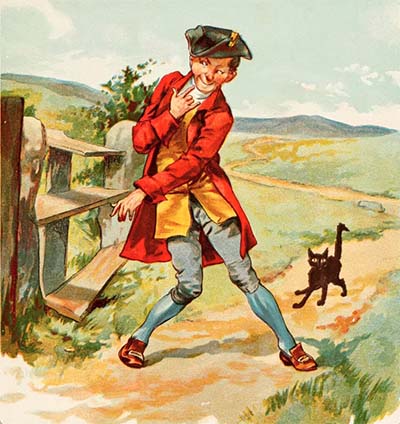There Was a Crooked Man
There was a crooked man,
And he went a crooked mile,
He found a crooked sixpence
Against a crooked stile;
He bought a crooked cat
Which caught a crooked mouse,
And they all lived together
In a little crooked house.

Origins
There Was a Crooked Man rhyme first appeared in print in James Orchard Halliwell’s The Nursery Rhymes of England (1842), though it had almost certainly been passed around by word of mouth long before that.
Meaning
 Two main explanations are usually given for its imagery. One is political. The “crooked man” is said to represent Sir Alexander Leslie, a Scottish general from the 1600s who signed the National Covenant, securing religious and political freedoms for Scotland during the reign of King Charles I. In this reading, the “crooked stile” symbolizes the difficult border between England and Scotland, while the “crooked house” stands for their uneasy union.
Two main explanations are usually given for its imagery. One is political. The “crooked man” is said to represent Sir Alexander Leslie, a Scottish general from the 1600s who signed the National Covenant, securing religious and political freedoms for Scotland during the reign of King Charles I. In this reading, the “crooked stile” symbolizes the difficult border between England and Scotland, while the “crooked house” stands for their uneasy union.
The other is place-based. The medieval town of Lavenham in Suffolk is famous for its timber-framed houses, many of which lean and tilt in odd angles after centuries of settling. The crooked buildings there are often pointed to as a real-life inspiration for the rhyme.
There’s also a practical detail in the verse: the “crooked sixpence.” After England’s 1696 recoinage, thin silver coins bent easily in use. So a crooked sixpence was something people actually saw in their daily lives.
At its simplest, the rhyme is a playful pattern: repeat “crooked” over and over until everything in the story is bent, odd, or off-kilter. Children loved the sound of it, and the pictures it conjured — a crooked mile, a crooked coin, a crooked cat and mouse tucked into a crooked house.
The political reading adds more weight: a crooked border, crooked dealings, and a crooked house representing an alliance that never felt entirely stable. Whether you read it as satire or as nonsense, it remains memorable because the word “crooked” turns ordinary things strange and striking.
 Cultural Background
Cultural Background
When Halliwell printed it in 1842, it quickly found its way into children’s books, where illustrators ran with the imagery. Victorian drawings showed leaning houses, tilted stiles, and cats and mice at odd angles. The repetition of “crooked” wasn’t just a word game anymore — it became a whole visual world.
That’s part of why the rhyme stuck. It was easy to memorize, fun to chant, and irresistibly drawable. Children got the rhythm, parents got the joke, and illustrators got endless crooked details to fill the page.
Today it survives in anthologies, picture books, and even tourism — Lavenham still points proudly to its “Crooked House.” Whether you take it as satire, local legend, or just wordplay, the crooked man and his crooked house are likely to keep their place in nursery lore for many years to come.

